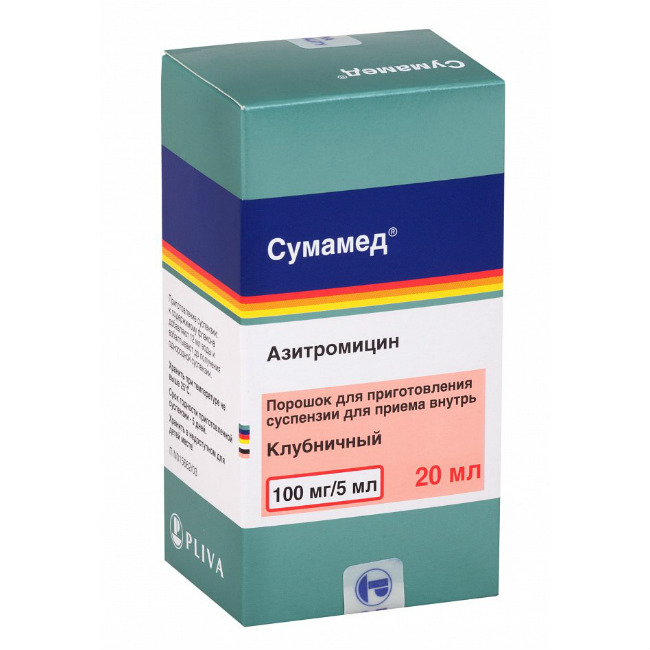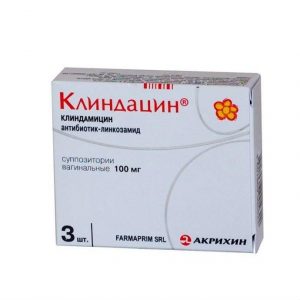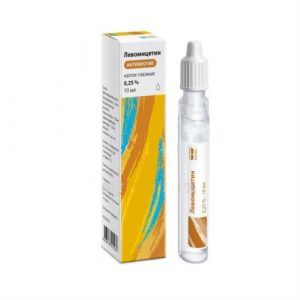Description
Release form
Powder for preparing a suspension for oral
Packaging
In 50 ml dark glass vials complete with a double-sided dispensing spoon and dosage syringe in a box 1 set
Pharmacological action
Sumamed – an antibiotic of the macrolide group – azalide. It has a wide range of antimicrobial effects. Binds to the 50S subunit of the ribosome, inhibits the biosynthesis of protein microorganisms. In high concentrations it has a bactericidal effect.
Azithromycin is active against gram-positive aerobic bacteria: Streptococcus pneumoniae, Streptococcus pyogenes, Streptococcus agalactiae, Streptococcus viridans, streptococci groups C, F and G, Staphylococcus aureus, Staphylococcus epidermidis bacteriaphyriform bacteria.
Azithromycin is active against gram-negative aerobic bacteria: Haemophilus influenzae, Haemophilus parainfluenzae, Haemophilus ducreyi, Moraxella catarrhalis, Bordetella pertussis, Bordetella parapertisseris, Berlissa mellis infection, Neisseria gonorrrhoeae, Jerisseri malaria
Azithromycin is also active against intracellular and other microorganisms: Mycobacterium avium complex, Legionella pneumophila, Chlamydia trachomatis, Chlamydia pneumoniae, Mycoplasma pneumoniae, Ureaplasma urealyticum, Listeria monocitogenes, Borrelia burgdorferi, Treponema pallidum.
Gram-positive bacteria resistant to erythromycin are resistant to the drug.
Indications
Infectious and inflammatory diseases caused by microorganisms sensitive to the drug: – infections of the upper respiratory tract and ear (bacterial pharyngitis, tonsillitis, sinusitis, otitis media)
– infections of the lower respiratory tract (bacterial bronchitis, interstitial pneumonia exacerbation of chronic bronchitis)
– infections of the skin and soft tissues (chronic migratory erythema – the initial stage, Lyme disease, erysipelas, impetigo, secondary dermatoses)
– infections, p redavaemye sexually (urethritis, cervicitis)
– diseases of the stomach and duodenum associated with Helicobacter pylori.
Contraindications
– severe impaired liver and kidney function
– hypersensitivity to antibiotics of the
macrolide group Precautions: during pregnancy and lactation, with impaired liver and kidney function, in patients with impaired or predisposed to arrhythmias and QT prolongation.
Use during pregnancy and lactation
During pregnancy, the drug should be administered only if the expected benefit to the mother outweighs the potential risk to the fetus. If it is necessary to administer Sumamed to women during lactation, it is necessary to decide on the termination of breastfeeding.
Composition
5 ml of the prepared suspension contain azithromycin dihydrate 100 mg
excipients: sucrose, sodium phosphate, hyprolose, xanthan gum, cherry, banana, vanilla, silicon dioxide colloidal flavorings.
Vial contains 400 mg of azithromycin.
Dosage and administration
The drug is administered orally 1 time per day, at least 1 hour before or 2 hours after eating.
The required dose is measured using a syringe or a measuring spoon: with a body weight of up to 15 kg, a syringe is used, with a body weight of more than 15 kg – a measuring spoon.
For infections of the upper and lower respiratory tract, ENT organs, skin and soft tissues (except for chronic migratory erythema), 10 mg / kg of body weight is prescribed 1 time / day for 3 days, course dose – 30 mg / kg .
In case of chronic migratory erythema:
on day 1 at a dose of 20 mg / kg body weight and then from 2 to 5 days – daily at a dose of 10 mg / kg body weight, course dose 60 mg / kg.
Rules for the preparation of a suspension
To the contents of the bottle add 11 ml of water and shake. The volume of the resulting suspension is 25 ml. The shelf life of the prepared suspension is 5 days.
Before administration, the contents of the vial are thoroughly shaken until a homogeneous suspension is obtained. Immediately after taking the suspension, the child is given a few sips of water to rinse and swallow the remaining amount of the suspension in the oral cavity.
After use, the dosing syringe is disassembled, washed with running water, dried and stored in a dry place.
Side effects
Rarely (in 1% of cases or less).
From the digestive system: melena, cholestatic jaundice, nausea, vomiting, diarrhea, constipation, decreased appetite, gastritis, a reversible moderate increase in the activity of liver enzymes.
From the urinary system: jade.
From the reproductive system: vaginal candidiasis.
From the cardiovascular system: palpitations, chest pain.
From the side of the central nervous system and peripheral nervous system: dizziness, headache, vertigo, drowsiness, increased fatigue in children – headache (with treatment of otitis media), hyperkinesia, anxiety, neurosis, sleep disturbances.
Allergic reactions: skin rashes, Quincke’s edema, urticaria, conjunctivitis.
Dermatological reactions: photosensitivity, pruritus.
On the part of laboratory parameters: in some cases – neutrophilia, eosinophilia (changed indicators return to normal 2-3 weeks after discontinuation of treatment).
Drug Interaction
Antacids (containing aluminum, magnesium), ethanol and food greatly reduce the absorption of azithromycin (capsules and suspension), so the drug should be taken at least 1 hour before or 2 hours after taking these drugs and meals.
Azithromycin, unlike other macrolide antibiotics, does not bind to isoenzymes of the cytochrome P450 system. No interactions with theophylline, terfenadine, carbamazepine, triazolam, digoxin have been reported to date.
Macrolides with simultaneous standard receiving with cycloserine, nepryam my anticoagulants, methylprednisolone, felodypynom and drugs podverhayuschymysya mykrosomalnomu oxidation (cyclosporine, heksobarbytal, alkaloyd spor ny, valproevaya acid dyzopyramyd, bromocriptine, fenytoyn, oral hypohlykemycheskye sredstva) zamedlyayut withdrawal, pov shayut concentrations and toxicity ukazann h drugs, while the use of azalides, such interaction has not been observed to date.
Careful monitoring of prothrombin time is recommended when co-administered with warfarin.
The simultaneous administration of macrolides with ergotamine and dihydroergotamine may result in their toxic effect (vascular spasm, dysesthesia).
Linkosamines decrease and tetracycline and chloramphenicol increase the effectiveness of azithromycin.
Pharmaceutically azithromycin incompatible with heparin.
Overdose
Symptoms: nausea, vomiting, diarrhea, temporary hearing loss.
Treatment: symptomatic.
Storage conditions
Keep out of the reach of children at temperatures from 15 ° to 25 ° C.
Expiration
2 years.
The Expiration of the prepared suspension is 5 days.
Deystvuyuschee substances
Azithromycin
Dosage form
Dosage form
suspension for oral administration
Pliva Hrvatska doo, Croatia




